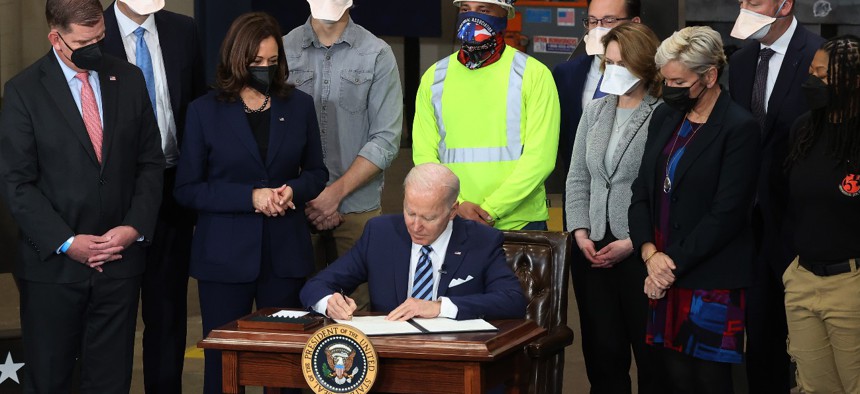
Chip Somodevilla/Getty Images
Biden’s Latest Executive Order Seeks to Promote Efficiency in Federal Construction Contracting
The move aligns the administration's goals of increasing participation in unions and using federal procurement to advance equity.
President Biden signed an executive order on Friday afternoon requiring project labor agreements on federal construction contracts start at $35 million, which he says will promote workers rights and efficiency.
The president signed the executive order at the office of Ironworkers Local 5, which represents 1,000 ironworkers in the Mid-Atlantic region, including journeymen, apprentices, and retirees, in Upper Marlboro, Md. He was joined by Vice President Kamala Harris and Labor Secretary Marty Walsh, who also made remarks. The executive order aligns with the Biden administration's goals to increase participation in unions and use federal procurement to advance equity.
Project labor agreements are a type of collective bargaining “that contractors, subcontractors and unions put in place before a construction site gets underway,” Biden explained at the event on Friday. “They ensure that major projects are handled by well-trained, well-prepared highly skilled workers. And they ward off problems. They resolve disputes ahead of time, ensuring safer work sites, avoiding disruptions in work stoppages that can cause expensive delays down the line. And that makes a big difference for the American taxpayer.”
According to a fact-sheet from the White House, “federal construction projects span the country – from the maintenance of nuclear sites to base construction to waterways and flood projects.” The White House estimates the order could affect $262 billion in federal government construction contracting and improve quality of jobs for almost 200,000 workers on these contracts, based on fiscal 2021 figures. Project labor agreements can allow for better coordination on large and complex projects; bolster the quality standards for bidders on federal projects; and standardize work rules and compensation costs, among other things, according to the White House.
“This is a historic win for working people all across this country,” Walsh told the audience. It’s also a reminder that “this is the most pro-labor, pro-worker administration in our nation’s history.”
The executive order also directs the Defense and Labor departments and Office of Management and Budget to spearhead a training strategy for the contracting workforce on project labor agreements as well as how to implement the order.
“This training will create a more uniform and accessible experience for contractors interacting with departments and agencies across the federal government,” according to the fact-sheet.
As for provisions of the Infrastructure Investment and Jobs Act, the executive order does not apply to construction projects that are funded through grants to non-federal entities.
President Obama issued a similar executive order in February 2009, encouraging the use of project labor agreements for federal construction projects. Further back, President H. W. Bush signed an executive order in October 1992 banning the use of project labor agreements for federal or federally funded construction projects, which President Clinton revoked in February 1993. Clinton then issued a memo in June 1998, encouraging the use of these agreements for contracts over $5 million on construction of facilities that would be owned by a federal agency or department, said a 1998 report from the General Accounting Office, which was later renamed the Government Accountability Office.
Response to the executive order was mixed.
Stephen Sandherr, CEO of the Associated General Contractors of America, an association for the construction industry, came out against the order.
“Construction workers are among some of the highest paid workers in the economy, earning 10% more than the average worker in the U.S,” he said in a statement. “Government-mandated project labor agreements undermine the collective bargaining process by imposing a separate agreement in a specific region that applies only to a limited number of construction firms and unions.”
Also, an analysis done during the Obama administration of federal construction procurement by the Defense Department “found that in 99.4% of construction projects where a [project labor agreement] could have been imposed, nonpartisan federal officials found no benefit to taxpayers from imposing one.” The association obtained this information through a Freedom of Information Act request.
The White House noted this is one of several steps the Biden administration has taken to “improve the efficiency of federal procurement.” Other actions included: strengthening “Buy American” rules, working to reduce worker turnover on service contracts, and requiring contractors to pay workers on new or extended contractors to pay a $15 minimum wage.
The Associated Builders and Contractors also came out against the executive order.
Meanwhile, the Association of Union Constructors is supportive of it.
“This executive order proves once again that [project labor agreements] are the best choice for construction projects of all types and sizes,” as they “save time and money,” said Daniel Hogan, association CEO, in a statement to Government Executive. “They are relied upon every day in the private sector because they deliver substantial safety and productivity advantages.” He added that these agreements were “used to complete some of the most iconic public works projects in American history, including the Hoover and Grand Coulee Dams.”
Jason Walsh, executive director of the BlueGreen Alliance, which unites labor unions and environmental organizations to solve environmental issues, applauded the executive order.
“By making sure we are attracting and retaining skilled workers, we can avoid delays and bid overruns and protect taxpayer money with better project outcomes—including safeguarding the environment,” he said in a statement.







